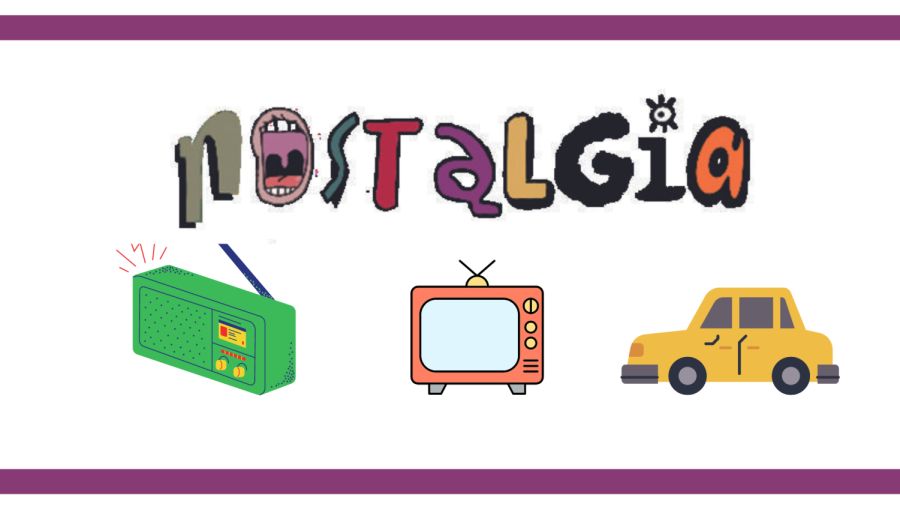Nostalgia: a double-edged sword
Used with Permission by Canva/Artwork by Jada Sandvall
Nostalgia is commonly defined as an emotional longing for the past, which could entail feelings of happiness, sadness or anything in between.
November 15, 2022
Every generation has been affected by their longing for the “good ol’ days.” Whether it be the 40-year-olds who continue their “Friends” obsession, baby boomers who reminisce about the days before computers or teenagers who reflect on the world before COVID-19.
But what even is this feeling that is so universal to the human experience? How does it affect daily life?
Nostalgia is commonly defined as an emotional longing for the past, which could entail feelings of happiness, sadness or anything in between. It forms at a crossroads between the sadness of loss and the happiness that the memory or time holds, making nostalgia a uniquely complex emotional phenomenon. The concept of nostalgia itself has been around for generations; however, the definitions and opinions surrounding it have not always been the same.
In 1688, Swiss physician Johannes Hofer proposed the term and concept of nostalgia. Hofer was merely a 19-year-old medical student, yet his proposition affected the views of many other doctors for centuries. According to the National Institutes of Health, this original idea of nostalgia “referred to a state of moral pain associated with the forced separation from family and social environment.”
While Hofer is credited with naming the phenomenon, nostalgia existed for many years before his proposal. Julie Beck from The Atlantic states that “during the Thirty Years’ War…the disease came to be associated with soldiers, particularly Swiss soldiers, who were reportedly so susceptible to nostalgia when they heard a particular Swiss milking song, Khue-Reyen, that its playing was punishable by death.” Because of strong effects like these, nostalgia was actually considered to be a psychological disorder, and this definition persisted for many years into the 20th century.
There were even proposed cures to nostalgia, none of which proved to help anyone. Beck also states that some of the treatments included “leeches, purging the stomach and ‘warm hypnotic emulsions,’ whatever that unspeakable horror might be.”
As time progressed and medical practices modernized, nostalgia slowly escaped its negative connotations. As Laine Kaplan-Levenson from NPR puts it, “after about 100 years of searching for a literal nostalgia bone in the body, doctors started to slowly give up on the idea that nostalgia was a physical illness.” In other words, many doctors realized that it was not an ailment, but rather an aspect of the human experience. The concept that Hofer formed eventually lost its credibility. Kaplan-Levenson also discusses how people realized that “nostalgia wasn’t a disease, and it wasn’t straight-up homesickness. It wasn’t an incurable illness, but an incurable, modern condition in reaction to modernity itself.”
Nowadays, nostalgia has become a topic of daily conversation and media. It can be triggered by almost anything, from music or TV to even the most random of objects. As modernization rages on, new trends flood the world and people rapidly move from place to place, nostalgia is more common than ever. It goes further than just an emotion; nostalgia serves multiple purposes for the human psyche throughout every stage of life. Psychologist and professor Dr. Krystine Batcho tells the the American Psychological Association that “nostalgia, by motivating us to remember the past in our own life, helps to unite us to that authentic self and remind us of who we have been and then compare that to who we feel we are today.” In the ever-changing modern world, it has become so easy to lose sight of a true sense of self, demonstrating a need for nostalgia.
Yet, our minds continue to trick us into believing that the past was a perfect paradise that is no longer attainable. Dr. Batcho also adds that scientists “have decades of cognitive research that show that the general default is that memories are not accurate, and that’s true for all kinds of memories.” A baby boomer may be nostalgic for the days of “flower power” and Woodstock, but they could forget to think about the violence and widespread racism that occurred during that time. In this way, nostalgia acts as a double-edged sword. People can gain comfort through romanticizing the past, but they can also distort the true reality of life, causing them to reach for a past and present that simply does not exist.
As Dr. Valentina Stoycheva from Psychology Today states, “reflecting on the past…can undoubtedly offer significant benefits for well-being. However, when taken to an extreme, nostalgia can…lead to unhelpful behaviors and negative consequences, and…prevent us from utilizing more helpful coping strategies.” Hence, there can always be too much of a good thing. When experienced in moderation, nostalgia can be a needed comfort in reaction to a rapidly changing society. Too much reliance on it, however, can lead to an extreme contortion of the past to fit an unrealistic mold that could damage a person’s psychological outlook for years to come.
Both the history and modern understanding of nostalgia show that the present is the best place to be, well, present. By taking one day at a time, people may realize that the “good ol’ days” have been here all along.









